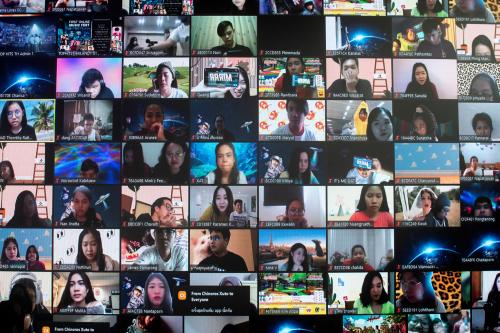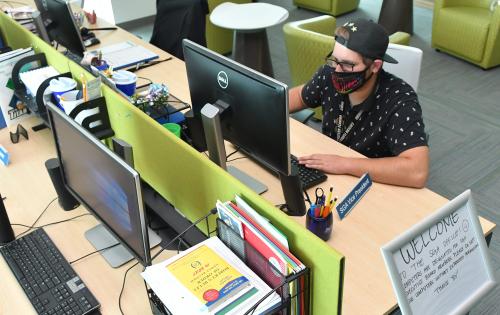In the two years since the start of the COVID-19 pandemic, we have all become familiar with the world of virtual meetings. While the challenges of breakout rooms, registration links, and muted microphones are as frustrating today as they were in 2020, the shift has also revealed some surprise benefits by fostering more inclusive and diverse participation in events designed to foster learning. At the Millions Learning project at the Center for Universal Education, where we hosted or co-hosted more than 30 online events with participants hailing from over 58 different countries, the shift to online platforms forced us to become more comfortable with hosting events in different languages for people based all around the world. We’ve made mistakes along the way, but in doing so we have gained a much better understanding of how to plan and execute virtual events. Most importantly, we’ve learned that we cannot just take what we did in person and copy and paste it for the virtual world. Inclusive, engaging online events must be designed differently from the start.
1. Collaboration takes time, flexibility, and understanding—but it’s worth it
While it may be easier and more efficient for a single organization to plan and execute a virtual event, there are numerous benefits to taking a partnership approach—from bringing in diverse perspectives and varied experiences to expanding the network of participants who are invited to engage in the event. However, genuine collaboration takes time, work, and mutual respect. It is important to allot sufficient time and plan accordingly for partners to feed into all stages of the process—from identifying learning objectives to planning agendas and creating learning materials. A collaborative approach may also require the leading organization to let go of its preexisting ways of working and be open to alternative processes, comfort zones, and planning timelines.
2. Recognize participants’ time, contributions, and effort
Though logging on to a virtual webinar may seem simple, participants are giving their own time, energy, and expertise when they participate in online events—especially in events where organizers expect participants to be actively engaged in discussions and do preparatory work before or between sessions. As a result, it is important to recognize attendees’ contributions and the time commitment that comes with virtual participation. Certificates and other forms of recognition are good ways to recognize the effort and acknowledge participants’ choice to engage.
3. A truly bilingual event requires more than just interpretation–it must be factored into every element of the event design
Modern communication platforms and AI translators have made it easier to provide interpretation, translation, and transcription for online events. While these factors are essential, they are not by themselves sufficient for making a learning experience truly bilingual (or multilingual). In our experience, simply offering simultaneous interpretation and encouraging attendees to chime in using their own language still results in an English-dominated conversation. For participants to feel comfortable speaking in their preferred language and to view the event as authentically bilingual (rather than an English event with interpretation), it is important to create presentations and hold discussions in multiple languages. For example, having an initial presentation done in English followed by a panel discussion in French enables all participants to divide time between listening in their own language and listening to interpretation and demonstrates a commitment to engagement from all. It is also useful to share learning materials and presentation slides in all languages ahead of time so that they can follow along during the event in their preferred language. And don’t forget about the chat! It is key to ensure that communication sent to participants in the chat box goes out in all languages used during the event. Finally, while automated translation applications have improved significantly over the past few years, it is still helpful to have translated documents reviewed by a native speaker to ensure they are accurate and idiomatic.
4. Keep it simple; keep it inclusive
Although there are many ways to create opportunities for engagement in virtual meetings, it is essential to recognize that not all participants can always access or use these tools in the same way. Especially when working across geographies, time zones, and languages, it is important to think about how breakout rooms, polls, chat boxes, whiteboards, and other devices are intended for use. If there are issues with bandwidth (which happens to us all!) or many participants will join on mobile devices rather than computers, it is important to make sure the tools and activities don’t create complications or exclude participants. The best way to ensure everyone can engage is to keep events simple in format and to allow people to engage on or off video, on a computer or on a phone, or in any other situation. Too many features can distract from or sabotage authentic and meaningful conversation.
5. Breakout rooms are a double-edged sword
Nothing has given us more stress than the “breakout rooms” option afforded by Zoom and other virtual learning platforms. The ability to divide participants into smaller groups can be valuable to provide opportunities for active engagement and networking during a large virtual event and enables organizers to group attendees by topics of interest or shared language. At the same time, breakout rooms can bring real logistical issues that can create more problems than they solve. It can be challenging to assign participants to rooms in advance, since some individuals may choose to join using another device or email address than they registered with, or some attendees might show up without registering. However, it can be equally challenging to ask participants to “opt in” to the room of their choice, as this can cause real confusion, take significant time, and many participants might end up remaining in the main room inadvertently. While there is no one-size-fits-all solution to this problem, we have found it is important to plan adequate transition time for moving to and from breakout rooms in the agenda and to include clear written and verbal instructions for participants in multiple languages. We also have found it is best to use breakout rooms sparingly—only when the purpose and utility is clear and essential. As simultaneous interpretation is currently unavailable in breakout rooms, it is also important to establish workarounds like organizing groups by language or creating separate Zoom meetings to allow for multilingual discussions in small groups.
6. Interesting content is the best way to provoke good engagement
It is vital to always ensure enough time and space for participants to share their own thoughts, questions, and experiences. At almost every event we have held, participants shared that they wished there was more time for questions and conversation. The best discussions come in response to thought-provoking questions or detailed sharing of experiences, so it’s important to create space for this throughout the session and not just at the end. Not everyone engages in the same way, so it is also a good idea to have multiple ways for participants to share their ideas— such as in the chat box, speaking out loud, follow-up surveys, etc. We have learned the effective facilitation of participatory conversations is an art, not just standard practice.
7. Learning is a two-way journey
Events should not only be learning experiences for the participants—they are also wonderful opportunities for the partners, presenters, and panelists to learn from attendees. Framing the session as a mutual learning experience can help ensure a collaborative dynamic is set from the beginning. This requires a mindset that recognizes the expertise and experiences of participants, not just presenters. This joint learning approach can also help provide the space to make on the fly corrections when challenges arise during the event (and they always do). For example, if it seems that an activity is not working, believing that the event is a learning opportunity encourages facilitators to stop, acknowledge the moment, and adjust to the realities of the situation. In this same vein, event planners will do well to solicit feedback from all participants after the event, discuss and learn from how things went, and write down for next time the challenges and surprise opportunities that came up.
Three years into the pandemic, we all know how challenging virtual learning can be. But we also know that when we do it with an open mind, a collaborative spirit, and an eye on conversational equity, we can create authentic spaces for mutual learning and exciting discussion.
The Brookings Institution is committed to quality, independence, and impact.
We are supported by a diverse array of funders. In line with our values and policies, each Brookings publication represents the sole views of its author(s).









Commentary
7 lessons learned for virtual events
July 25, 2022